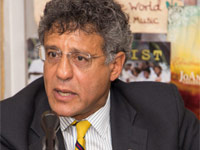Must history always repeat itself? We are indeed on the verge of what could turn out to be another major food crisis. The FAO Food Price Index at the end of 2010 returned to its highest level. Drought in Russia and the export restrictions adopted by the government, together with lower crop harvests than expected, first in the United States and Europe, then in Australia and Argentina, have triggered a process of soaring agricultural commodity prices on international markets.
Admittedly, the present situation is different from that of 2007-2008, although recent climatic events may significantly reduce agricultural production next season. The hike in prices concerns sugar and oilseeds in particular, more than grains which account for 46 percent of calorie intake globally. Cereal stocks amounted to 428 million tonnes in 2007/08 but stand currently at 525 million tonnes.
However, they are being seriously drawn down in order to meet demand. On another front, oil prices are at around 90 dollars a barrel, instead of 140 dollars. No doubt higher prices and volatility will continue in the next years if we fail to tackle the structural causes of imbalances in the international agricultural system. We continue to react to circumstances and thus to engage in crisis management.
The underlying problems were identified in 1996 and 2002 at the FAO World Food Summits. On both occasions, the attention of the highest authorities of the world was drawn to the failure to deliver on commitments. If current trends persisted, the goals set by the world leaders of reducing by half the number of hungry people on the planet by 2015 would only be achieved in 2150.
There has been no decisive change in policy since 1996, despite the warnings by the Global Information and Early Warning System of FAO and those issued through the media. Yet, today there are still close to one billion people who are hungry.
We must therefore forcefully remind everyone the conditions needed for an adequate supply of food for a population that is constantly growing and that, in the next forty years, will require a 70 percent increase in agricultural production worldwide and a 100 percent increase in the developing countries.
First is the issue of investment: the share of agriculture in official development assistance (ODA) dropped from 19 percent in 1980 to 3 percent in 2006, and now stands at around 5 percent – it should amount to 44 billion dollars per year and return to its initial level that helped to avert famine in Asia and Latin America in the 1970s; the budgetary expenditure of low-income food-deficit countries on agriculture represent about 5 percent, when this should be at least 10 percent; finally, domestic and foreign private investments of around 140 billion dollars per year should amount to 200 billion dollars. These figures are to be compared to global military expenditure of 1 500 billion dollars per year.
Then there is the issue of international trade in agricultural commodities which is neither free nor fair. The OECD countries protect their agriculture with a total support estimate of 365 billion dollars per year, and the subsidies and tariff protection in favour of biofuels divert some 120 million tonnes of cereals from human consumption to the transport sector. Further, unilateral sanitary and phytosanitary measures and technical barriers to trade are hampering exports, particularly from the developing countries. Finally, there is the subject of speculation that is exacerbated by the measures of liberalisation of agricultural futures markets in a context of economic and financial crisis.
These new conditions have served to convert hedging instruments into speculative financial products replacing other less profitable forms of investment. The solution to the problem of hunger and food insecurity in the world therefore requires an effective coordination of decisions on investment, international agricultural trade and financial markets. In an uncertain climatic context marked by floods and droughts, we need to be in a position to finance small water control works, local storage facilities and rural roads, as well as fishing ports and slaughterhouses, etc.
Only then will it be possible to secure food production and enhance the productivity and competitiveness of small farmers, thus lowering consumer prices and increasing the income of rural populations who make up 70 percent of the world’s poor. We must also reach a consensus on the very lengthy negotiations of the World Trade Organisation (WTO) and put an end to the market distortions and restrictive trade practices that are aggravating the imbalances between supply and demand.
Finally, there is a pressing need for new measures of transparency and regulation to deal with speculation on agricultural commodity futures markets. Implementation of such policies at the global level requires the respect of the commitments made by the developed countries, notably at the G8 Summits of Gleneagles and L’Aquila, as well as at the G20 Summit in Pittsburgh.
Developing countries, for their part, must increase their national budget allocations to agriculture. And private foreign direct investment needs to be made in conditions that will ensure in particular, thanks to an international code of conduct, an equitable sharing of benefits among the different stakeholders.
Crisis management is essential and a good thing, but prevention is better. Without long-term structural decisions and the necessary political will and financial resources for their implementation, food insecurity will persist with a succession of crises affecting most seriously the poorest populations. This will generate political instability in countries and threaten world peace and security. The speeches and promises made at major international meetings, if not acted upon responsibly, would only fuel a growing sense of frustration and revolt.
The time has come to adopt and implement policies that will enable all farmers of the world, in developing and developed countries alike, to earn a decent income through mechanisms that do not create market distortions.
These men, women and youths must be allowed to exercise their profession under conditions of dignity so we can feed a planet that will grow from 6.9 billion inhabitants at present to 9.1 billion in 2050.
By Jacques Diouf
Director-General of the Food and Agriculture Organisation of the United Nations (FAO)



